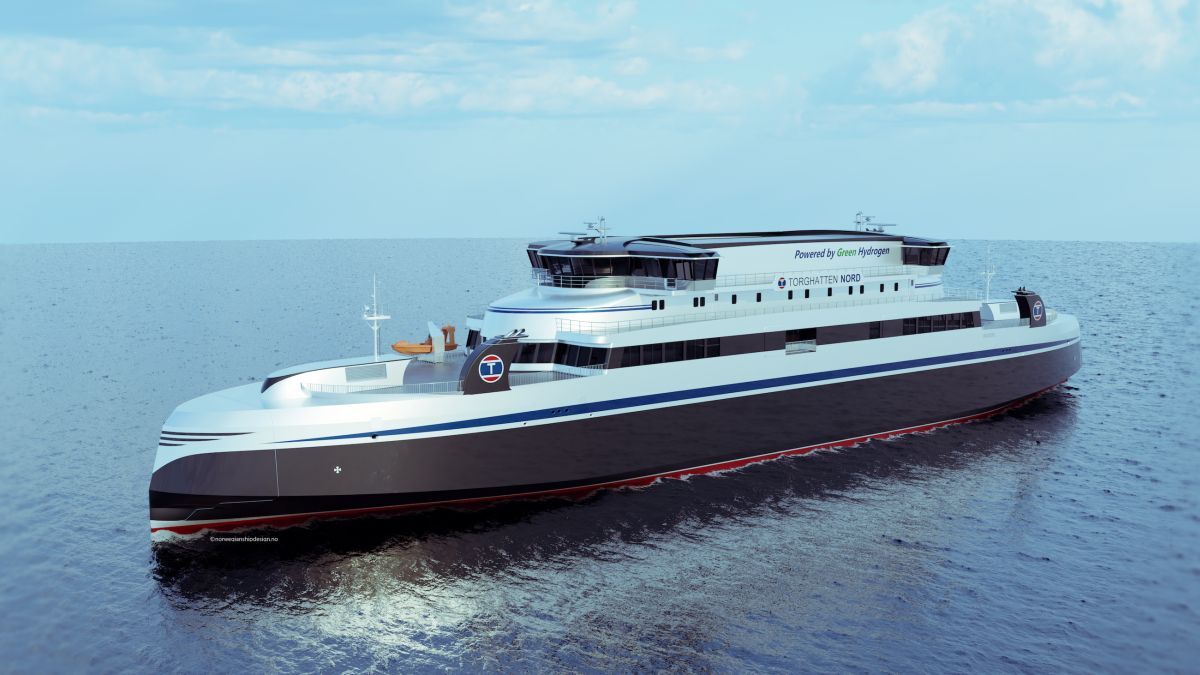 A rendering of Torghatten Nord’s hydrogen-powered ferry (source: The Norwegian Ship Design Co)
A rendering of Torghatten Nord’s hydrogen-powered ferry (source: The Norwegian Ship Design Co)
Shipping needs hydrogen to progress towards net zero under IMO’s drive to cut greenhouse gas emissions
A green fuel could be used from a liquefied or compressed gaseous state on board ships for the most efficient energy system and propulsion.
For this, much needs to be developed in terms of technology, bunkering infrastructure, rules, regulations and guidance, said experts from the maritime industry during Riviera Maritime Media’s Pathway to 2030 and beyond: Hydrogen as a marine fuel webinar. This was held 7 May during Riveria’sMarine Propulsion: Fuels Webinar Week.
On the panel were Zero Emissions Ship Technology Association secretary general Madadh MacLaine, Ricardo head of hydrogen business Joanna Richart and Lloyd’s Register’s Maritime Decarbonisation Hub lead for fuels and technologies Charlie McKinlay.
They agreed hydrogen holds promise as a future marine fuel for combustion engines and fuel cells for ferries, workboats, harbour vessels, shortsea shipping and eventually oceangoing ships.
This panel discussed safety considerations, such as the flammability and low ignition energy of hydrogen, requirements in ship design for safe storage, gas-tight compartments, airlocks, ventilation, exhaust monitoring and leak detection.
Ms MacLaine said there are several vessels, mainly passenger ferries, running on hydrogen and more are being built, indicating it is gaining traction as a marine fuel. There are also hydrogen-fuelled crew transfer vessels, a harbour tug, small container carrier and an autonomous superyacht. Under construction are hydrogen-fuelled container ships and bunkering vessels, while bunkering facilities are ready or being built in the Benelux countries, Germany, Norway, Japan and the US.
“There are several approvals in principle for hydrogen vessel designs, so it is coming already,” said Ms MacLaine.
She said more vessel owners would consider either liquid hydrogen (LH2) or compressed gaseous hydrogen (CGH2) if IMO and regional regulations and class rules were ready and effective. Instead, projects are leaning on IMO’s International Code of Safety for Ships using Gases or other Low-flashpoint Fuels (IGF) Code, which Ms MacLaine said was “not fit for purpose” for hydrogen.
“IGF Code addresses LNG, but this is different to how LH2 behaves,” she added. “We cannot assume anything in IGF Code is appropriate in hydrogen, so we have to go through everything. We will not get anywhere until regulations are in place.”
IMO is working on guidelines for using hydrogen fuels, as it is with other alternative fuels, using the IGF Code as a starting point.
Ms MacLaine is looking for guidance, which she expects to come in 2025, that is focused on safety, but with open options. “It is in our members’ best interest that regulations are not overly prescriptive and that the guidelines are open to options.”
Ms Richart expects IMO’s global fuel standards to be more stringent than FuelEU Maritime of the European Union, but shipping companies need to be confident of supply from bunkering infrastructure and have a reason to convert from fossil fuels.
“IMO is sending the industry the right message that they will have to do something,” she said. “The industry has awoken. Carbon levies mean owners will be paying penalties for not having solutions, so there will be people to buy hydrogen as a marine fuel.
“But it is not easy for vessel owners to make decisions, and ports need to be ready for bunkering. Owners will be buying ships that will still be at sea when regulations come into force.”
This means there needs to be technical solutions enabling larger ships to operate on LH2 or CGH2 in the long term. Ms Richart presented two research projects Ricardo is involved in, one in Scotland and the other with EU funding.
The HIMET decarbonisation project in Orkney, UK, uses a vessel retrofitted with hydrogen-combusting engines for trials with the fuel.
“There would be opportunities for ports in countries with solar power potential to produce and export green fuels”
The EU-funded sHYpS project is developing a method of stacking 375-kW fuel cells into a multi-MW solution for passenger ships. “There are space, weight and distribution challenges we need to address, through certification bodies and working with flag states,” said Ms Richart.
“We all need to decarbonise, but the supply chain, technology and regulations are not all there yet. But the future is exciting and is here now.
Mr McKinlay said hydrogen would be used for deepsea shipping, and not just shortsea and port vessels. However, much development work is required on fuel storage and incentives to fuel suppliers to generate green hydrogen for all industrial sectors, so “we go from a few-to-many to become a many-to-many market,” he added.
“There would be opportunities for ports in countries with solar power potential to produce and export green fuels, mostly derived from hydrogen. Then encourage owners to consider hydrogen as clean and completely zero emissions.”
Other fuels, such as methanol and ammonia, have other challenges, such as carbon emissions with methanol and unburned ammonia being a far more powerful greenhouse gas than CO2.
“We should use hydrogen for well-to-wake efficiency, but with CGH2, we need more space for storage so it is considered for shortsea vessels,” said Mr McKinlay.
It is difficult to manage if there are leaks due to its high pressure. The maritime industry has more experience with liquefaction and cryogenic systems required for LH2.
“LH2 is known but the low temperatures are challenging. Hydrogen is difficult to transport so it is good to produce locally.” Ships would need to bunker more frequently in multiple ports.
“The bottom line is who is going to pay for this?” said Mr McKinlay. “There is a risk, with carbon levies coming, of not having a pathway to net-zero emissions. There will be a multi-fuel future, so we need to find the energy systems that are most efficient.”





